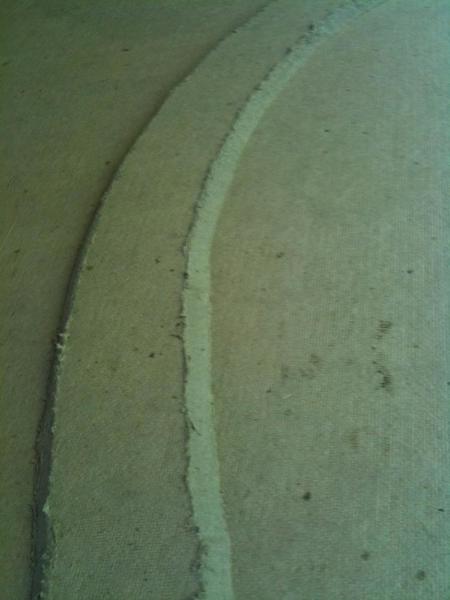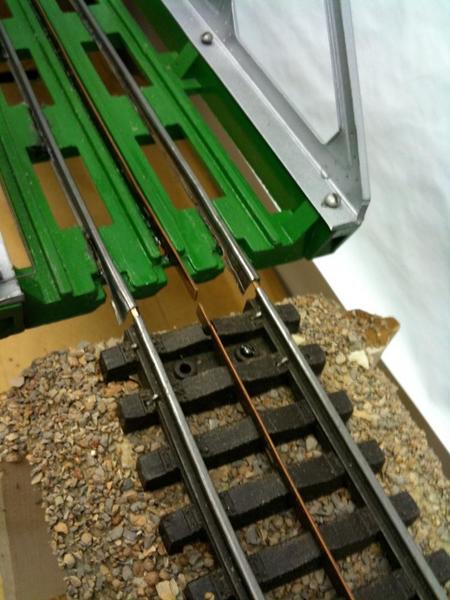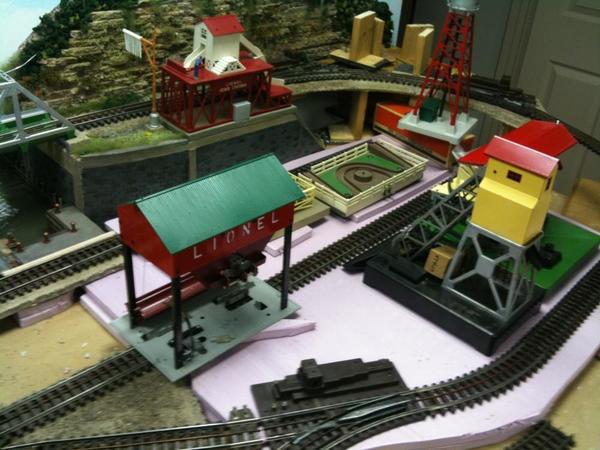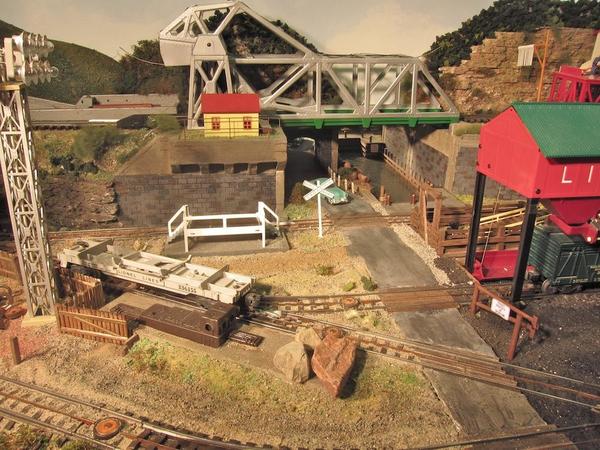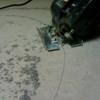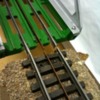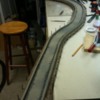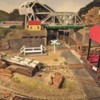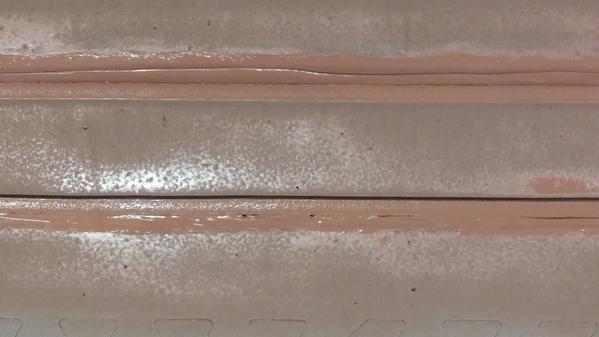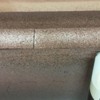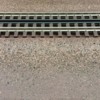Hi, I'm building a Standard Gauge layout and will be using a 1/2" ply covered with 1/2" Homasote. My layout is an odd size and there will be at least 5 seperate panels of both the ply and the Homasote. I would love to hide the gap lines between panels. My question is whether to fill/seal the gaps with sparkle or tape or caulk? (Or nothing?) . I understand that in heated dry indoor environments the Homasote will actually contract over time making gaps worse. Thoughts? Thanks.
Replies sorted oldest to newest
Is it possible to cover the whole layout surface with grass mats or something like that? Or are you going to have the painted homasote as your surface?
Steven J. Serenska
We covered the seems with masking tape and then painted it all an earth color.
What Doug said...I did the same.
Andy
PLCProf posted:A lot of the homasote (in the big box store, at least) has a very uneven thickness. Not bad if you only use 1 sheet, but if you use multiple sheets and put a thick end against a thin edge it could be a pain. I suggest you measure before you purchase.
Yes, I learned this the hard way.
Good to know. Thanks for the tips!!
All of our sheets had a thinner edge. Not a factor in 3 rail, nor the cracks. We live in Southern California so expansion, shrinkage, and of course earthquakes are always causing small cracks in the ground cover. No one can see our seems even with small cracks over time. Just freshen it up and they are gone again. No reason to over think or spend too much effort on those seams. ![]()
Serenska posted:Is it possible to cover the whole layout surface with grass mats or something like that? Or are you going to have the painted homasote as your surface?
Steven J. Serenska
Yes I am going to be painting the homasote. ![]()
Tom Tee posted:I run a vacuum equipped sander over all seams and 14" flat non notched trowel Ardex feather finish over all for a very flat surface. Essential with 0 two rail and smaller scale gauges IMO. Not so much with three rail. Yes, you can get slight seam cracks. Not much of a problem.
Question: Do you sand the entire surface smooth or just the seam.? I would like a smoother surface so I am going to give your method a try. Thanks. Because it is a going to be a very period looking SG layout, color is a major factor. I am going to paint the homaoste and having it smooth will help. One thing I might do is leave the unfinished unsanded homasote as the neatly sculpted ballast. Here's a picture of the mural I painted and the underway benchwork.
Attachments
While not addressing your question directly, NEVER cut homasote in the house if it can be avoided, even with a vacuum attached to the saw - it kicks up one heck of a lot of dust!!! Luckily, I was able to have Home Depot do 95% of my cuts.
I've used a lot of Homasote. They are right about not cutting it in the house, or train room: dusty! and probably not healthy for anyone's respiratory system.
I ended up using a very sharp blade and developed "Popeye" muscles from cutting out so much in cookie cutter fashion, I don't have sheet after sheet abutting each other. I senic-ed everything solving the gaps, unevenness, etc that you have mentioned.
Good Luck
ernie
Apples55 posted:While not addressing your question directly, NEVER cut homasote in the house if it can be avoided, even with a vacuum attached to the saw - it kicks up one heck of a lot of dust!!! Luckily, I was able to have Home Depot do 95% of my cuts.
I couldn't agree more.
My first attempt at cutting homasote 12 years ago was with a utility knife. It was a lot of work and the results were an uneven cut that looked like crapola.
My second attempt about a year ago involved getting a very fine-toothed 10" saw blade and installing it in reverse on my table saw, so that the teeth weren't cutting directly into the homasote. I'm still picking the dust out of my hair. To say it was a huge mess is an understatement.
My third attempt about six months ago involved using a jigsaw with a blade intended to cut aluminum to make a long, curved cut. Not as big a mess as the table saw, but a mess all the same.
My next (and final) attempts will involve drawing the curves that need to be cut with a sharpie, carrying the homasote down two flights of stairs, and cutting it outside in the yard on sawhorses using a jigsaw. In December and January. In New England. It will still be worth it.
Steven J. Serenska
I have found that if you put the paint on liberally the semi rough surface is about right for my non paved areas, For pastures and dirt areas the scale roughness left is great.
If you glue down your homasote you should get very little shrinkage, I would not use sparkle for the seams. I like to use the glue I used to glue it down with to fill any seams. I lay the glue down a little heavy at the joints and when the homasote goes down push a little glue out the seam. Let is sit a few minutes and with a putty knife trowel off glue going across the joint. This drags homasote fiber into the joint and when dry blends right in. I have used homasote for 30 years and very rarely would I ever use a power tool of any kind to cut it. Utility knife with fresh blades and a good straight edge and/or patience, score it many times will do a great job. For intricate cuts I put a hacksaw blade in a jab saw and take my time for a clean cut. If you must use a saw use a paneling saw blade put on backwards.
Every one has put in some good tips so good luck and stay safe.
Apples55 posted:While not addressing your question directly, NEVER cut homasote in the house if it can be avoided, even with a vacuum attached to the saw - it kicks up one heck of a lot of dust!!! Luckily, I was able to have Home Depot do 95% of my cuts.
Actually, if you use a band saw, it's not a problem.
First of all, I'd stagger the seams so the ply and Homasote don't come at the same places. Then, when you use your ground cover, it will fill up the gap and and then level off with the top and not need to be filled. If the cracks overlap, then the stuff would fall through to the floor.
I cut Homasote with a plane knife cutter in a saber saw. It's basically a blade without teeth and therefore, no dust. You could make your own if you have a bench grinder. I didn't use Homasote for the table tops, but I did use it for my workbench. It's a great workbench top since you can pin parts down with T-pins right over drawings for doing framing and model RC plane building.
Here is what I use instead of Homasote. http://www.harborfreight.com/c...lt?q=fatigue+matting I buy it when I have a 25 % off coupon or when it's on sale. It's 1/2" thick, 2' x 2'. There are 4 to a pack. Glue it down to the layout or just cut it with scissors as roadbed. It's VERY sound proof, easy to use, and much more durable. I do not screw the track down. I allow the track to float just like real tracks do. I hold the track in place with Frost King 3/8" wide x 3/16" thick weather seal. Then I run a bead of black latex caulk against the weather seal to help hold it down and also to create a tapered edge for the ballast. If you do not want to use ballast, the track can be lifted out of the way, then Krylon textured stone spray paint can be used to cover the weather seal. There is no need to screw the track down when done this way. The track in the photo is Atlas. This method will allow the track to expand and contract, and also the layout beneath it, without the track getting wavy. It will hold screws if needed , just be gentle when tightening down.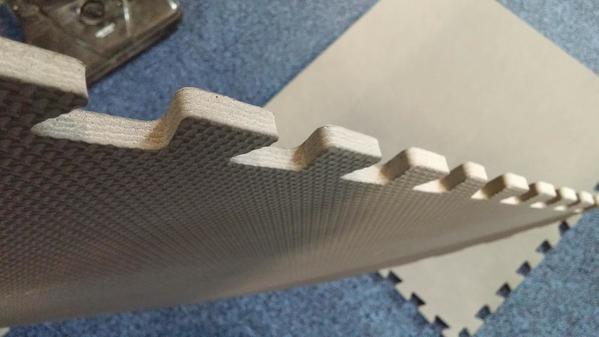
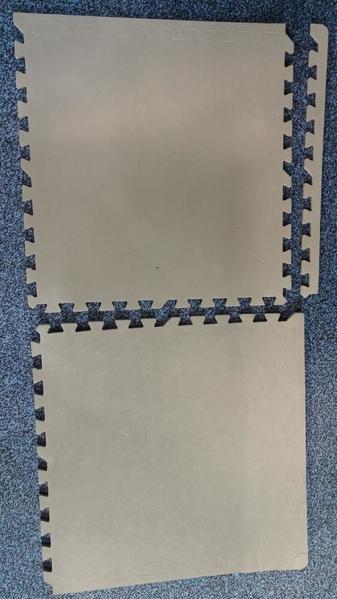
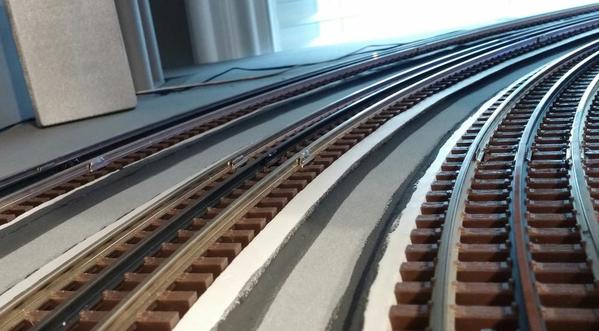
Attachments
Hi Guy's:
Correct on Homasote thickness variation.
If you put a blade in your saber saw (powered jig-saw) and set it at an angle, you can cut Homasote in your livingroom with absolutely no dust generation. Be sure the blade is sharp and you don't overheat it. I used a 1" belt sander to bevel the blade for a smooth transition without the angled grind. Then I used 600 grit emery to sharpen followed by an oilstone. I had to do this 3-4 times and broke 1 blade due to overheating and/or forcing a cut.
I did my entire 20' x10' layout roadbed under Atlas 2-rail layout and hand laid switches this way.

Check out the total absence of any dust on the smooth cut of this piece.
Thanks... Tom
Attachments
You might need to reload your photo, Tom.
Hi Guy's:
Correct on Homasote thickness variation.
If you put a blade in your saber saw (powered jig-saw) and set it at an angle, you can cut Homasote in your livingroom with absolutely no dust generation. Be sure the blade is sharp and you don't overheat it. I used a 1" belt sander to bevel the blade for a smooth transition without the angled grind. Then I used 600 grit emery to sharpen followed by an oilstone. I had to do this 3-4 times and broke 1 blade due to overheating and/or forcing a cut.
I did my entire 20' x10' layout roadbed under Atlas 2-rail layout and hand laid switches this way.

Check out the total absence of any dust on the smooth cut of this piece.
Thanks... Tom
Attachments
You may want to try vinabed roadbed instead of the homosote. It will only go under the track and is flexible to your curves.
F&G RY posted:You may want to try vinabed roadbed instead of the homosote. It will only go under the track and is flexible to your curves.
Do you have a link for their product? I can't find anything. Thanks. ![]()
Dreyfuss Hudson posted:Hi, I'm building a Standard Gauge layout and will be using a 1/2" ply covered with 1/2" Homasote. My layout is an odd size and there will be at least 5 seperate panels of both the ply and the Homasote. I would love to hide the gap lines between panels. My question is whether to fill/seal the gaps with sparkle or tape or caulk? (Or nothing?) . I understand that in heated dry indoor environments the Homasote will actually contract over time making gaps worse. Thoughts? Thanks.
I used homasote to cover our entire 16 x 33 layout (over 1/2" ply) and offer the following tips:
We live in hot humid summer / cold dry winter New England and painted homasote has not expanded or contracted whether glued or screwed down.
If you cut it with a jigsaw or other mechanized tool, it creates enough dust to blot out the sun and put us into another ice age. If, however, you use a straight edged blade in your jigsaw or cut manually with a utility knife sporting a fresh, sharp blade and take your time, there is no dust and you will have nice clean cuts. An added benefit to doing it manually is you lose weight (because over time it is a workout) and get well developed triceps muscles on your cutting arm.
You can use masking tape on seams, but if you're going to use ground cover, tape isn't really necessary as the gaps between homasote sheets are small.
It's true that big box store sheets aren't necessarily uniform in thickness, but the variance is very minor and I laid sheets next to each other right on the big box floor to get sheets that were uniform. A little extra time and effort, but if you want to use homasote, I would recommend.
Here's their address. Vinyl bed was their former product. The current (and better in my estimation) is Flexibed.
It's very good for sound reduction. It bends to most curves without cutting. It cuts easily with a utility knife for working about switches, etc. I glue it with foam adhesive or Liquid Nails construction adhesive and weigh it down with anything heavy I can find including Bricks.
Dave Zucal posted:Here is what I use instead of Homasote. http://www.harborfreight.com/c...lt?q=fatigue+matting I buy it when I have a 25 % off coupon or when it's on sale. It's 1/2" thick, 2' x 2'. There are 4 to a pack. Glue it down to the layout or just cut it with scissors as roadbed. It's VERY sound proof, easy to use, and much more durable. I do not screw the track down. I allow the track to float just like real tracks do. I hold the track in place with Frost King 3/8" wide x 3/16" thick weather seal. Then I run a bead of black latex caulk against the weather seal to help hold it down and also to create a tapered edge for the ballast. If you do not want to use ballast, the track can be lifted out of the way, then Krylon textured stone spray paint can be used to cover the weather seal. There is no need to screw the track down when done this way. The track in the photo is Atlas. This method will allow the track to expand and contract, and also the layout beneath it, without the track getting wavy. It will hold screws if needed , just be gentle when tightening down.
Dave - can you post some photos of the various stages, or if you don't have, at least the finished product (some up close photos too please) to better illustrate?
I cut Homasote cookie-cutter style, by laying out the track plan on a sheet and tracing it. I then cut with a saber saw set at an angle for beveled edges. Gluing on sifted kitty litter gets you nice looking ballast. What I like about this technique is that it lets you create grades (both large and subtle) very easily.


Attachments
If I were getting back into the hobby, I would use the material Dave Zucal mentioned. On my present layout we used 20 sheets of Homasote, and its very DUSTY if you cut it with an electric hand saw, saber saw, but better with a Knife blade in the jig saw.... It is an uneven material and you may need to level your track with shims.....We nailed ours down to the 5/8 Plywood, painted it several times, and after using cork roadbed, atlas O track, ross turnouts, etc. we used scenic express ballast, and grass materials to cover the homasote. We have not seen any shrinkage do to our scenic effects.... This material will hold screws and they will not vibrate out. This being said, I would look at the newer material mentioned above by Dave.......My layout was started in 2000, Homasote $22 for a 4X8 sheet. I had to get this in Nashville, Tn.......
Here is another product like Vinabed . . .
Midwest cork roadbed. It will do HO, S and O scale track when it's separated.
It's on Page 30 of their innovative catalog.
Sorry PJB that I didn't post more pictures above. Here is the steps and more photos. I use Krylon Stone or Rust-Oleum American Accent Stone Texture. Rust-Oleum will not eat this type of foam.
1. Weather strip and caulk down each side of track. Let dry over night.
2. Lift out the track and primer ( Amer. Accent Primer ) Let dry a few hours.
3. Lay cardboard in where the track would lay.
4. Spray light coats of Stone Texture. If you spray too heavy it will turn to mud. It's water based so you can help it dry between coats with a hair dryer after the air clears of the cans propellant.
5. Lift out cardboard and re-insert track.
6. Ballast if you wish, but it will reflect more sound.
Attachments
Just cut it outside. Pretty simple.
Dreyfuss Hudson posted:Hi, I'm building a Standard Gauge layout and will be using a 1/2" ply covered with 1/2" Homasote. My layout is an odd size and there will be at least 5 seperate panels of both the ply and the Homasote. I would love to hide the gap lines between panels. My question is whether to fill/seal the gaps with sparkle or tape or caulk? (Or nothing?) . I understand that in heated dry indoor environments the Homasote will actually contract over time making gaps worse. Thoughts? Thanks.
When I built my benchwork I used Celotex or what is called sound board. ( I am 62 and never have I seen or come across Homasote ) I painted all the sheets with cheap white paint before cutting. The white surface helps with marking cut lines. And did all the cutting outside, yes is is messy but not much more than plywood. After cutting I then painted the cut edges with the white paint. I just screwed down the celotex to the plywood. To cover the joints I got some old cotton bed sheets and cut into 3 " strips, then soak the strips in a mix of white glue and water. Cover the joints with the cloth strips. Be careful to not get wrinkles, and feather out the edges by brushing on extra water / glue mix. When the glue dries, I then painted the whole top of the surface with a cheap tan colored latex paint. The covered joints almost disappear.
Steve
Homasote / http://www.homasote.com/
You may want to check out their Home Page. with videos.....
Gary and
Attachments
trainroomgary posted:Homasote / http://www.homasote.com/
You may want to check out their Home Page. with videos.....
Gary and
Gary:
Do you have a link to a specific video that would help? I looked through the site and all I found was this under the "Tips" page:
All Homasote products may be cut with a circular saw, jig saw or hand saw. Do not use a fine-tooth blade; fiber build-up will reduce cutting efficiencies. The half-inch panels may also be cut with a razor or utility knife.
As someone who has used both a circular saw and a jig saw on this stuff, I'm gonna have to give that one a big "Yeah, right..." As PJB brilliantly stated above, cutting homasote this way "creates enough dust to blot out the sun."
In all seriousness, did I miss a video showing proper handling/cutting procedures?
Steven J. Serenska
I have found that using an old fashioned hand saw, yes a hand saw, like carpenters used to use does not create a lot of dust, but I usually go outside to do my cutting if at all possible.







